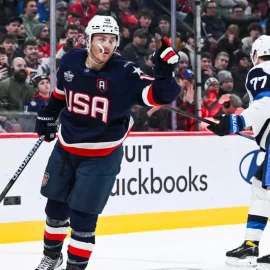Late last night, TSN 1200’s Shawn Simpson got the rumour mill churning.
https://twitter.com/TSNSimmer/status/1341600281562411009
Thanks to their projected cap hit of $84.97 million, the Arizona Coyotes exceed the $81.5 million upper cap limit. Marian Hossa’s placement on the LTIR will free up his $5.275 million cap hit, but there is no question that moving a veteran like Derek Stepan would create come more cap flexibility for the Coyotes.
Stepan is currently in the last year of the six-year $39 million contract that he signed in 2015 with the New York Rangers. Although the cap hit was palatable in the first few years of his contract, but Stepan is now on the wrong side of 30 and has seen his effectiveness and production diminish.
So why would the Senators have any passing interest in such a player?
To start, the money is not that glaring of an issue.
Although Stepan’s cap hit is $6.5 million, the front-loaded nature of his contract calls for him to earn $5.0 million in real dollars this season. Most importantly, a significant chunk of his total salary for the 2020-21 season has already been covered by the Coyotes. Earlier this offseason, they covered the cost of his $3.0 million signing bonus meaning that Stepan is only owed $2 million for the remainder of his contract.
The Senators do have an influx of centres already on the roster. Chris Tierney, Colin White, Logan Brown, Josh Norris, Artem Anisimov, Alex Galchenyuk and Nick Paul all have played centre at the NHL level. Looking at this depth and low expectations accompanying this organization for the shortened 56-game season, adding another inconsequential veteran to the mix is not really necessary.
Management may disagree with that assertion.
Over the past number of years, this organization has repeatedly proven that it is more comfortable acquiring and relying on placeholder veterans than it is providing its young prospects with an opportunity to play regularly and develop at the NHL level.
If the Senators do add Stepan to the mix, it will reflect their comfort level using veterans like him and Chris Tierney as their first and second line centres.
Eventually at some point, the organization is going to have to create room for its young players.
Colin White, for example, spent a season playing on the team’s first line alongside Brady Tkachuk and put up 41 points. That is one more 40-plus point season than Derek Stepan has had over the past two seasons.
An early season injury hampered White’s play early last season and eventually forced him to spend some time on the shelf. During his absence, Jean-Gabriel Pageau ascended to White’s spot and never relinquished it. Although it was great that this role helped boost Pageau’s trade profile and netted the Senators a strong return for the centre at the trade deadline, his play reduced White to a lesser role where he simply struggled to replicate the success of his freshman campaign.
There definitely is something to be said about linemates like Mark Stone and Brady Tkachuk boosting White’s profile and production during his first year. Over the past year, I’ve written about some of the underlying metrics that highlight White’s strengths. The numbers prove that White can be a capable defender who has an underrated knack for moving and transitioning the puck well through the neutral zone.
The uncertainty lies in his offensive upside.
Is White strictly a third line player or can he be a little more?
Prospects like Logan Brown, Josh Norris and even a Shane Pinto project as players who should eventually profile as second or third line pivots. Eventually, Tim Stützle may get a chance to prove that he can play the position, but that won’t happen this season. The organization has already indicated that he will be given a chance to make this team as a left winger.
So without any real high-upside centres in the mix in the interim, shouldn’t the organization extend White an opportunity to reunite and play alongside Tkachuk or other skilled forwards in the top-six to assess and get a better grasp of what White’s offensive upside is?
White is safely projectable centring a team’s third line and worst-case, maybe there is a chance he slides to the wing if other prospects like Norris or Pinto eventually prove to be better alternatives.
On what’s expected to be a bad Senators team, he probably warrant a look to play top-six minutes this season.
Considering he turns 24 years old next month, this is not some green prospect who is just entering the league and needs to be sheltered. The organization felt confident enough in his abilities to reward him a six-year $28.5 million contract ($4.75 million AAV), maybe management and the coaching staff could invest a little faith in White as a player now.
White is safely projectable centring a team’s third line and in Ottawa, maybe there is a chance he slides to the wing if other prospects like Norris or Pinto eventually prove to be better alternatives.
Acquiring Stepan essentially would push White down the lineup and box prospects like Norris and Brown out of a regular spot.
Is it worth it?
That depends on the opportunity cost involved.
Since the Coyotes are pushed up against the cap ceiling, Pierre Dorion could leverage their situation and take on Stepan in exchange for some future asset or two. As a small market team, it would be advantageous for Senators to continue to stockpile draft picks and prospects that the team can use: 1) to replenish its roster with inexpensive players as veterans become too expensive; or 2) as trade chips to supplement its young core down the road when the team is actually expected to be better.
If the Senators received a prospect or pick from the Coyotes and then flipped Stepan for another pick or two near the trade deadline, that would be savvy. The Senators would be leveraging their cap space to acquire futures. It would only cost them money. Think of how this would be such a marked and welcomed change from the way this organization has operated over the last five to 10 years.
The only concern is that the Senators may actually target Stepan believing him to be a significant upgrade on what they already have.
The risk therein is that the team may willingly move future assets of their own to acquire Stepan.
The centre posted four consecutive seasons in which he registered 50-plus points between the 2013-14 and 2017-18. Over the last two years however, he has failed to score more than 15 goals or 35 points.
Historically, Stepan’s been a terrible faceoff guy (45.9 career FO%), but in using NaturalStatTrick.com’s data, Stepan’s underlying numbers at five-on-five over the last four years have not been horrendous.
| Season | CF% | SF% | SCF% | GF% | xGF% |
| 2016-17 | 50.77 | 51.98 | 51.37 | 59.49 | 52.37 |
| 2017-18 | 49.20 | 47.65 | 48.04 | 52.69 | 47.01 |
| 2018-19 | 50.38 | 51.22 | 49.54 | 46.67 | 50.46 |
| 2019-20 | 49.36 | 48.98 | 46.73 | 45.90 | 47.95 |
Stepan’s metrics reflect that his team essentially gives as much as it gets in terms of its shot and goal generation. A deeper look into his team’s shooting percentages when Stepan is on the ice reveals that at five-on-five, his teams have often shot very well. In the formative years of his career, his team’s shooting percentage was consistently over eight or nine percent when Stepan was on the ice. It even reached as high as 10.57 percent during the 2015-16 season. Over the last two seasons however, Stepan’s teams have scored on 6.35 and 5.77 percent of their shots. It is a sizable drop that can help explain why Stepan’s production has suffered over the past two seasons.
The Senators could look at this information and talk themselves into the idea that this is a great opportunity to buy low on a player who could outproduce his recent totals and help return the Senators a relatively good asset at the trade deadline.
What would not make any sense is for the Senators to use any combination of draft picks or prospect depth to acquire a stopgap solution. Making this type of trade would be consistent with many of the moves that this organization has made in the past: flipping commodities (prospects, draft picks) for players who won’t discernably make this team better or effect the team’s anticipated placement in the standings.
Granted, the Senators could flip a draft pick or prospects for Stepan and recoup an asset or two at the deadline, but chances are in this scenario, the price paid at the deadline for this rental will be less than the opportunity cost that the Senators could spend now. (Example: trading one of the team’s second round picks now and then flipping Stepan for a third later.)
Maybe the addition of another veteran will help make it easier for management to stomach another non-playoff season, but adding Derek Stepan to this roster will not change the likelihood that this team will miss the postseason.
So, unless you’re leveraging this Arizona situation to your favour, how does adding Stepan benefit your future self?
I don’t buy into the argument that the prospects will benefit from being sheltered a little longer.
There needs to come a time when this organization will stop bragging about the young talent it has acquired and instead focus on making room for it on the parent roster. A player like Colin White has already enjoyed some developmental success in Ottawa and prospects like Josh Norris, Logan Brown, Erik Brannstrom and Alex Formenton have had success in Belleville.
The organization needs to start integrating some of these players into the lineup. This shortened season will not only allow them to play NHL games, but meaningful games every night against some good competition. It should help give these prospects an understanding of what it will take to become a competitive team.
Add The Sports Daily to your Google News Feed!






